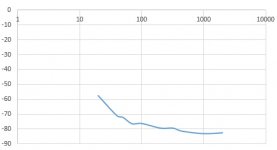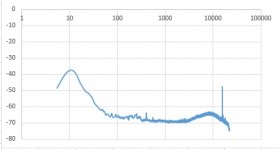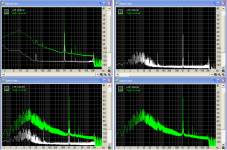I don't get the message. My plot had nothing to do with blank grooves.
Simply making the point that IME the LP surface is the limiting factor not pre-amp noise especially at the splitting hairs level.
Sorry for the dumb question, but what is the spectrum of the LP surface noise. I just realised that I'd never bothered to even think about it. I assume its whitish and then gets pinked up by the RIAA eq but might be totally wrong.
If my assumption is right and my brain is starting to work again after days of beechams hot lemon then within reason* you only need to worry about noise at 1kHz** and making sure that is far enough below vinyl surface noise as to be not audible/tweak your OCD?
*I also assume that the front end will not be using devices with a 1/f knee at 1kHz
** looking at equal loudness contours, for anything other than shellac noise will be low enough level that you can boost it 40dB at 100Hz ref 1kHz for the same audibility. Might be missing something
If my assumption is right and my brain is starting to work again after days of beechams hot lemon then within reason* you only need to worry about noise at 1kHz** and making sure that is far enough below vinyl surface noise as to be not audible/tweak your OCD?
*I also assume that the front end will not be using devices with a 1/f knee at 1kHz
** looking at equal loudness contours, for anything other than shellac noise will be low enough level that you can boost it 40dB at 100Hz ref 1kHz for the same audibility. Might be missing something
You are a right that just looking at preamp noise figures has it's limits.Sorry for the dumb question, but what is the spectrum of the LP surface noise. I just realised that I'd never bothered to even think about it. I assume its whitish and then gets pinked up by the RIAA eq but might be totally wrong.
If my assumption is right and my brain is starting to work again after days of beechams hot lemon then within reason* you only need to worry about noise at 1kHz** and making sure that is far enough below vinyl surface noise as to be not audible/tweak your OCD?
*I also assume that the front end will not be using devices with a 1/f knee at 1kHz
** looking at equal loudness contours, for anything other than shellac noise will be low enough level that you can boost it 40dB at 100Hz ref 1kHz for the same audibility. Might be missing something
Aiming for preamps with 0.2nV/rtHz is a fantastic technical achievement, but is totally useless, 75dBA is more than enough.
Looking at the picture below, recorded with an MC element and a 75dBA preamp, you see going from bottom to top @ 1Khz, 1) noise with rotating platter, but arm in the air, 2) Surface noise from blank groove on LP and 3) spectrum while playing a 0dB 1Khz test tone.
Recording was made after Riaa, without A-weighting and with fixed width FFT filters.
As you can see, noise from 1) lies everywhere at least 15dB below the surface noise. Less noise from a preamp doesn't make sense.
Hans
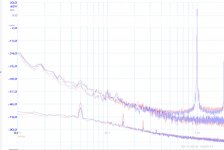
Thank you, Hans.You are a right that just looking at preamp noise figures has it's limits.
Aiming for preamps with 0.2nV/rtHz is a fantastic technical achievement, but is totally useless, 75dBA is more than enough.
..(..)...
As you can see, noise from 1) lies everywhere at least 15dB below the surface noise. Less noise from a preamp doesn't make sense.
Hans
View attachment 613629
Yes, I agree. This is exactly the point I've been posting as to intrinsic cartridge/preamp noise: it's not the issue. It's why I sit out such discussions. Because, though I salute the pursuit of technical achievement for the sake of it, there's no point here in preamp applications, IMO; at least for all reasonable designs.
LD
Hans' well measured surface noise measurements over 2 decades are very interesting, methinks. One can reverse eq RIAA correction to leave the native output from the MC cartridge.
Then cart/preamp noise is quite accurately white.
But surface noise has the following profile, which suggests some derivative time dependence that has me puzzling, and I think is very interesting. It is heavily lf loaded.
Thoughts as to the physical meaning of this cartridge output spectrum, ie stylus velocity, versus frequency, due to surface noise: ??
LD
Then cart/preamp noise is quite accurately white.
But surface noise has the following profile, which suggests some derivative time dependence that has me puzzling, and I think is very interesting. It is heavily lf loaded.
Thoughts as to the physical meaning of this cartridge output spectrum, ie stylus velocity, versus frequency, due to surface noise: ??
LD
Attachments
Here's a 'RIAA off' spectrum plot of one of my silent groove archive recordings. MM/MI with conventional 47k/C loading.
I think this suggests dominant noise contribution in Hans' plot over the 2 decades he plotted might be baseband residue from the c 10Hz main cart-arm resonance.......?
Otherwise, I think the surface noise in this recording, as measured at the cartridge output without RIAA, is fairly white. ie stylus velocity noise seems fairly white. It also has what looks like some sort of c10kHz hf noise elevation, perhaps a resonant system perhaps the LCR or even mechanical - I don't know the cart details but it would have been conventional 47k/C MM/MI loading from the time?
There's a spike at exactly 15625Hz, which is ye olde UK TV line frequency from the days of CRT television, which I assume to be on the vinyl mastering, 'cos I didn't have an old tv at the time !?!
LD
I think this suggests dominant noise contribution in Hans' plot over the 2 decades he plotted might be baseband residue from the c 10Hz main cart-arm resonance.......?
Otherwise, I think the surface noise in this recording, as measured at the cartridge output without RIAA, is fairly white. ie stylus velocity noise seems fairly white. It also has what looks like some sort of c10kHz hf noise elevation, perhaps a resonant system perhaps the LCR or even mechanical - I don't know the cart details but it would have been conventional 47k/C MM/MI loading from the time?
There's a spike at exactly 15625Hz, which is ye olde UK TV line frequency from the days of CRT television, which I assume to be on the vinyl mastering, 'cos I didn't have an old tv at the time !?!
LD
Attachments
Last edited:
LD,Here's a 'RIAA off' spectrum plot of one of my silent groove archive recordings. MM/MI with conventional 47k/C loading.
I think this suggests dominant noise contribution in Hans' plot over the 2 decades he plotted might be baseband residue from the c 10Hz main cart-arm resonance.......?
Otherwise, I think the surface noise in this recording, as measured at the cartridge output without RIAA, is fairly white. ie stylus velocity noise seems fairly white. It also has what looks like some sort of c10kHz hf noise elevation, perhaps a resonant system perhaps the LCR or even mechanical - I don't know the cart details but it would have been conventional 47k/C MM/MI loading from the time?
There's a spike at exactly 15625Hz, which is ye olde UK TV line frequency from the days of CRT television, which I assume to be on the vinyl mastering, 'cos I didn't have an old tv at the time !?!
LD
To be honest, I do not see that much difference between your plot and mine. No more than a few insignificant dB's deviation from each other.
I have projected both on top of each other, after having adjusted the hor. and vert. scale to be exactly the same for both images.
Hans
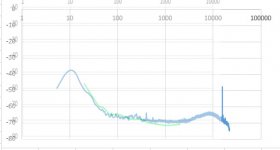
Yes, I agree, Hans. The two results are supportive.LD,
To be honest, I do not see that much difference between your plot and mine. No more than a few insignificant dB's deviation from each other.
I have projected both on top of each other, after having adjusted the hor. and vert. scale to be exactly the same for both images.
Hans
View attachment 614321
I think perhaps the dominant shape over the 1st two decades might be due to residue of the cart-arm resonant system at c 10Hz?
LD
15750 Hz is/was US TV line frequency AFAIK, and 15625 UK TV line frequency.......... !Quite a few of my vinyls have 15625 or 15750Hz peaks in them...
LD
Yes, I agree, Hans. The two results are supportive.
I think perhaps the dominant shape over the 1st two decades might be due to residue of the cart-arm resonant system at c 10Hz?
In high resolution FFT we see the arm/cart resonance around 10Hz plus a forest of peaks due to eccentricity (peaks every 0.55Hz).
If there was no eccentricity, the upper skirt of the FFT would be around 12-15 dB down at sub frequencies.
Vinyl noise (flat reproduction) is essentially flat above 50Hz
White trace: Flat reproduction of 1KHz lateral @ 7cm/sec test track (2minutes long).
Green trace: Analog RIAA reproduction (Hagerman Bugle) of the same test track.
Upper left FFT : 65536 points.
All the other FFTs: 2097152 points
Shure M97xE on SME 3009 II Improved, Thorens TD160MKII
Test track: Side 1 Track 1 of the "Ultimate Analog Test LP" form "Analog Productions".
George
Attachments
Thank you, I think your explanation is right, George.Vinyl noise (flat reproduction) is essentially flat above 50Hz
Flat above 50Hz implies stylus noise velocity per Hz is effectively constant, and that would be consistent with 1/f stylus displacement amplitude. Which is a very natural law, consistent with flicker too and, I believe, a friction connection perhaps.
LD
Which is a very natural law, consistent with flicker too and, I believe, a friction connection perhaps.
LD
Yes virtually all physical processes.
Hi George,In high resolution FFT we see the arm/cart resonance around 10Hz plus a forest of peaks due to eccentricity (peaks every 0.55Hz).
If there was no eccentricity, the upper skirt of the FFT would be around 12-15 dB down at sub frequencies.
Vinyl noise (flat reproduction) is essentially flat above 50Hz
White trace: Flat reproduction of 1KHz lateral @ 7cm/sec test track (2minutes long).
Green trace: Analog RIAA reproduction (Hagerman Bugle) of the same test track.
Upper left FFT : 65536 points.
All the other FFTs: 2097152 points
Shure M97xE on SME 3009 II Improved, Thorens TD160MKII
Test track: Side 1 Track 1 of the "Ultimate Analog Test LP" form "Analog Productions".
George
Interesting observations, showing 1/f noise from 50Hz downwards.
But allow me to have a few comments from my side.
I have the impression that the noise from your A/D is corrupting the images, for two reasons.
1) When the noise above 1Khz would be white, the noise in the green curve would have to drop 20dB from 1Khz to 20Khz.
2) the difference between the white and the green curve should be the difference between Riaa and no Riaa, but isn't.
Since RMAA that you are using does not show absolute levels, it would as a check make sense to have a recording with one channel playing through the flat preamp channel (white) and a the same time the other channel with no LP input (a second Cart connected or a resistor?) Then you have the relative difference between the two, confirming that either the recorded LP noise is significant and really white above 50 Hz or corrupted somewhere by the noise from the recording chain.
- A much lesser point that I question is that above 20Khz the spectra do change so abruptly. In #638 the same effect for a pink noise spectrum was explained by pink noise being band limited, but that cannot be the case here.
And since both white and green spectra above 20Khz are almost the same , it can probably only be your A/D causing this.
Hans
I wanted to test if I can hear any difference when using the Aurak V3 set for the Shure M97xE and when using the Hagerman Bugle.
Here are three recordings of the 1st side of
http://www.diyaudio.com/forums/atta...lowtorch-preamplifier-part-ii-front-cover.jpg
(the same music piece I used to test differences btn analog RIAA and DSP minimum/linear phase RIAA back in Oct 2016)
1. Shure M97xE+Aurak V3
https://www.dropbox.com/s/3ulkbt7aj4nqexs/1%20Shure%20M97xE%2BAurak%20V3.wav?dl=0
2. Shure M97xE + Hagerman Bugle
https://www.dropbox.com/s/pb56acwtpvlq1fo/2%20Shure%20M97xE%2BHagerman%20Bugle.wav?dl=0
3. Denon DL-103+head pre+Hagerman Bugle
https://www.dropbox.com/s/jtmmxu2iwz6o4uk/3%20Denon%20DL-103%2BHead%20pre%2BHagerman%20Bugle.wav?dl=0
I thought to share. They will be there for a few days.
Original recording was 24b/96KHz. Dithered (TPDF) and saved as 16b/44KHz wav for uploading to dropbox.
George
Here are three recordings of the 1st side of
http://www.diyaudio.com/forums/atta...lowtorch-preamplifier-part-ii-front-cover.jpg
(the same music piece I used to test differences btn analog RIAA and DSP minimum/linear phase RIAA back in Oct 2016)
1. Shure M97xE+Aurak V3
https://www.dropbox.com/s/3ulkbt7aj4nqexs/1%20Shure%20M97xE%2BAurak%20V3.wav?dl=0
2. Shure M97xE + Hagerman Bugle
https://www.dropbox.com/s/pb56acwtpvlq1fo/2%20Shure%20M97xE%2BHagerman%20Bugle.wav?dl=0
3. Denon DL-103+head pre+Hagerman Bugle
https://www.dropbox.com/s/jtmmxu2iwz6o4uk/3%20Denon%20DL-103%2BHead%20pre%2BHagerman%20Bugle.wav?dl=0
I thought to share. They will be there for a few days.
Original recording was 24b/96KHz. Dithered (TPDF) and saved as 16b/44KHz wav for uploading to dropbox.
George
Since we are talking about LF resonance I wanted to raise the damping spectre again. Lipshitz did an analysis for warp induced resonance and recommended a 25/75% mix of damping at cart end and pivot end. Now with warps I can understand that, but for generally wibblyness at LF does this still hold, or is it better to focus, townsend style at the cartridge end?
Hi Hans.
Good points your 1 and 2.
I’ll try to do what you suggest with the flat preamplifier.
As for the rest, 0dB for my soundcard (thus for the FFT) is 1.286V (edit:Vrms) The track from which the FFT was drawn was 1KHz @7cm/s.
The sudden drop above 20KHz was due to the USB channel bandwidth limitation forcing the card to sample at 48KHz, while the software was recording with 96KHz sampling rate.
George
Good points your 1 and 2.
I’ll try to do what you suggest with the flat preamplifier.
As for the rest, 0dB for my soundcard (thus for the FFT) is 1.286V (edit:Vrms) The track from which the FFT was drawn was 1KHz @7cm/s.
The sudden drop above 20KHz was due to the USB channel bandwidth limitation forcing the card to sample at 48KHz, while the software was recording with 96KHz sampling rate.
George
Hi Hans.
Good points your 1 and 2.
I’ll try to do what you suggest with the flat preamplifier.
As for the rest, 0dB for my soundcard (thus for the FFT) is 1.286V (edit:Vrms) The track from which the FFT was drawn was 1KHz @7cm/s.
The sudden drop above 20KHz was due to the USB channel bandwidth limitation forcing the card to sample at 48KHz, while the software was recording with 96KHz sampling rate.
George
Hi George,
Thanks for your answers.
And as for your listening test in #715, I would love to hear your own subjective judgment on the three audio fragment.
I compared parts of the Aurak and Hagerman fragments and found the Aurak sounding more open, with better articulation of voices and positioned the solist better in front.
Hans
Have you got a link for this?Lipshitz did an analysis for warp induced resonance and recommended a 25/75% mix of damping at cart end and pivot end. Now with warps I can understand that, but for generally wibblyness at LF does this still hold, or is it better to focus, townsend style at the cartridge end?
My own analysis in Jurassic times was firmly in favour of damping at the cartridge end using the V15-4 & later damped brush which I believe is also on the M97 and the basis for the Townsend.
Paper is AES E-Library Impulse Response of the Pickup Arm-Cartridge System
Whilst trying to find the reference I found this https://en.wikibooks.org/wiki/Engineering_Acoustics/Phonograph_Sound_Reproduction which has a mechanical model for the cartridge. Interestingly this is the 'perceived wisdom' of a totally rigid cantilever and compliant vinyl. I'd not seen these sort of models before (too young is my excuse 🙂 ).
Whilst trying to find the reference I found this https://en.wikibooks.org/wiki/Engineering_Acoustics/Phonograph_Sound_Reproduction which has a mechanical model for the cartridge. Interestingly this is the 'perceived wisdom' of a totally rigid cantilever and compliant vinyl. I'd not seen these sort of models before (too young is my excuse 🙂 ).
- Home
- Source & Line
- Analogue Source
- mechanical resonance in MMs
